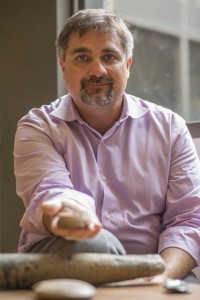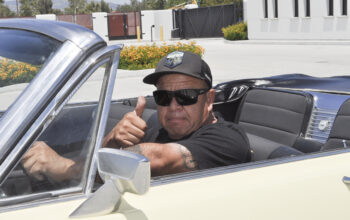
Through archeology, the secrets of lost civilizations are revealed, and what was once unknown can now be explored. Archeologist, Ronald “Sonny” Faulseit, has a drive to discover what once was, and now is.
Faulseit, instructor of anthropology and geographical sciences, enjoys going out on the field, learning about ancient society, and experiencing other cultures and their traditions. His passion for archeology is what drove him to become an instructor. However, Faulseit did not begin his work in archeology until the year 2000.
Faulseit has taught at other universities before instructing at Pierce. He has taught at DePaul University in Chicago, Southern Illinois University, and Tulane University in New Orleans.
It was difficult for Faulseit to settle down the first couple weeks of the semester when arriving from Chicago, but now that he is settled in, he is enjoying more of the campus and its atmosphere.
Erin Hayes, assistant professor of anthropology, believes that Faulseit is a really active and enthusiastic individual, and the department is excited to have him on their team.
“He’s awesome. He’s a hardworking guy that’s committed to archeology,” Hayes said.
Faulseit is a Postdoctoral Fellow at the Field Museum in Chicago, and specializes in the archaeology of the Oaxaca Valley of Mexico. He first began his venture as a chemist, working in an oil company outside of Chicago, and he later decided to go back to school and achieve his PhD as an archeologist.
Hayes said that Faulseit’s expertise in Mexico brings a global perspective of archeology to their department.
“We are a four field program that includes each of the subspecialties in anthropology, and archeology is one of them,” Hayes said. “He is a practicing archaeologist and has a field sight that he works on in Mexico. Which is not only a great way of being engaged in the field of archeology but will offer great opportunities for students who are interested in learning how to do archeology.”
Faulseit was also part of the military for a total of 17 years. He served in the United States Marines for two years, and another 15 in the Army National Guard.
Faulseit recently finished a project on Dainzú-Macuilxóchitl in 2015.
Dainzú-Macuilxóchitl is a town in the Oaxaca Valley of Mexico, where his project was founded. Faulseit has always been intrigued by ancient astronomy, but it was not until he was sent to Afghanistan for a year where he had to be an advisor, for the Afghan National Army’s Nation building, where he became aware of how nations collapse.
“I wanted to do my research on resilience and with the Oaxaca Valley, and the particular town I worked in, has been occupied for 700b.c. and through all kinds of changes,” Faulseit said. “The Aztec invaded, globalization, the Mexican War of Independence and the Mexican Revolution occurred. All these political changes happening and yet the community that I work in shows a lot of continuity from 700b.c. to today. So I wanted to look at what was the cultural reasons behind this.”
According to Faulseit, The Field Museum in Chicago has over 60 million objects in its collection and 3 million in anthropology.
“One thing that was really fun about working in the Field Museum was that there were biologist, zoologist, geologist, dinosaur hunters, and this whole group of different people that were there all the time,” Faulseit said. “There was all this great material that I was learning about constantly that wasn’t part of my field. We also had great exhibits from my field and we had a large group of objects I got to study, which came out from the Oaxaca Valley of Mexico.”
During the Dainzú-Macuilxóchitl project, Faulseit’s task was to compare archeological sites with modern day sites. Nevertheless, he got the full experience through the community when he decided to travel to their hometown.
Faulseit first traveled to the Oaxaca Valley of Mexico in 2002 and was taught their archaeological significance. He then continued his trips to their town for another 13 years. Last year, is when Faulseit decided to stay in Dainzú-Macuilxóchitl for almost all of 2015 before he got to Pierce College.
“For instance, the layout of houses is a communal effort. Though this is beginning to change from globalization,” Faulseit said. “But traditional Zapotec houses had a set of rules that they had to go by. They all look the same going from way back and this because they’re community projects. I see this in ancient houses that have excavated that have the same layout. So there’s this real continuity and sort of tradition going way back.”
Faulseit personally believes that the traditions in the Zapotec community in which he resided was the most interesting experience in his work. He was able to participate in their traditions and cultural dances. During his time spent in Mexico Faulseit also learned the term “cargo” which is a Spanish word for burden.
The community in where Faulseit worked explained to him the different positions and roles each had to partake in daily since their town does not pay financial taxes.
Faulseit explains that in addition to their cargo, every member of the community has to participate in the religious festivals.
“They are autonomous communities. They govern themselves and they use what is called Usos y Costumbres,” Faulseit said. “They governed me and that’s the way it should be. I was living in their community so I followed their rules. I had to live under Usos y Costumbres and really learn what it’s all about. Every time I needed to get a key to open a door I had to go see they keymaster. Who was a member of the committee, so I had to go get permission from the committee and then they had to communicate. Myself partaking in these and doing all the obligations and still running an archeological project at the same time was a real eye opener.”
Adrian Youhanna, department chair for anthropology and geography, agrees with Hayes with the department being excited to expand their archeology program.
Faulseit’s experience in North America has contributed a lot to their department. Youhanna is looking forward to the professor’s upcoming projects with his students. She would like the students to be more hands on when it comes to correlating both geography and anthropology.
“What I’m also excited about is that he has knowledge of geographic information systems, G.I.S. We are the anthropological geographical sciences, so it would be nice to marry these two disciplines together,” Youhanna said. “G.I.S. is basically automated mapping. It includes the technologies of GPS and automated mapping. So to be able to take students out on the field to an archeological field sight and have them collect and map data of artifacts is exciting. I think he is going to be a good addition because of his knowledge of G.I.S. and we can also integrate what he does with geography.”



